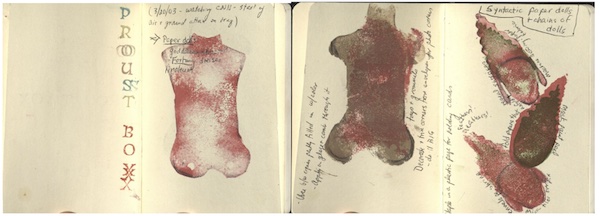Image caption: Proust Box notebook with notes on paper dolls, hexaflexagons (first pages), Eve Kosofsky Sedgwick Papers, Box 40.
Matilde Manara, a Postdoctoral Fellow at Institut Lethica, Université de Strasbourg, France, is a 2023-2024 recipient of the Eve Kososfsky Sedgwick Travel Grant.
I approached the materials held in Eve Kosofsky Sedgwick’s Papers as part of a larger project on feminist models of writing, behavior, and knowledge to be found in Marcel Proust’s A la Recherche du Temps Perdu. I am particularly interested in understanding how readers can acknowledge a literary model such as A La Recherche, recognizing its importance in their life and/or art, without necessarily embracing its esthetic, moral, or epistemological foundations (and even by openly rejecting them). Along with Sedgwick’s Works in Fiber, Paper and Proust (2005), I delved into Chantal Akerman’s La Captive (2000), Jacqueline Rose’s Albertine (2001) and Anne Carson’s The Albertine Workout (2014). An important part of this research deals with questions raised by Sedgwick herself in her writings on Proust. In the final chapter of Epistemology of the Closet, she notably writes:
I was reading Proust for the first time during just the short stretch of years during which it occurred to me to have ambitions that were not exclusively under the aspect of eternity: to want to publish visibly, know people, make a go it, get a run for my money. Oddly, of course, it was reading Proust that made me want these adventures and think I could find them. The interminable meditation on the vanity of human wishes was a galvanizing failure for at least one reader: it was, if anything, the very sense of the transparency and predictability worldly ambitions that gave me the nerve and skill to have worldly ambitions of my own. Like, I believe, most young women, I never had a shred of identification with JuIien Sorel or the nineteenth-century French male plot of conquering the capital – until after the years of Proust-reading; then both the hero’s airy ambition and his concomitant uncritical adoption of a master text became intelligible and engaging traits (Sedgwick 1990, 241).
In preparing my visit to Duke, I had planned to explore this potential identification by dividing the materials I expected to consult into two categories: those related to Sedgwick’s academic work (syllabi from the seminars she held on Proust from around 1998 up to 2009, notes and drafts for Epistemology of the Closet and The Weather in Proust, scattered articles, and records of conferences) on the one hand, and those related to her artistic work (textile art, artists’ books, pieces from her 2005 exhibition, Works in Fiber, Paper and Proust) on the other. The days spent at Duke made me realize how much my plan was naive, even somewhat paradoxical, for these two practices are deeply intertwined and connected to each other in the same “fractal” way she suggests Proust’s novel should be read (Sedgwick 2011, 90-93).
I was most struck by two aspects of the materials I had the chance to consult in the archive. First, to see how Proust’s novel, in both its material dimension (the printed paper) and its virtual dimension (the hypertextual lattice we discover when not following a linear progression), becomes itself the object of a découture (witnessed by pages and pages of copied, printed and collaged quotations organized by Sedgwick under thematic headings such as Weather, Interior-outside, Albertine, Happiness, Anxiety, etc.), thus allowing the book’s complex architecture to emerge, while at the same time making it possible to detach from it, or even build it anew. Second, to observe how these shredded fragments feed into Sedgwick’s vast and increasingly central reflection on immanence (drawn on Proust as much as on Buddhism or the philosophy of Plotinus) to such an extent that the underlined pages of the many (including some multilingual) versions of A la recherche she uses over the years bear testimony to this gradual convergence, revealing how transformative reading the novel could have been for her.
My time at Rubenstein library has certainly given me the opportunity to enrich my project, helping me to better understand how Sedgwick reads, writes and seals in Proust – and not on, as she meant by the title of her exhibition at Harvard in 2005, “Works in Fiber, Paper, and Proust.” But it has also, and most importantly, touched me on a personal level, made my Proustian reader self fully and enthusiastically agree with her when she notices that:
It is harder to say in what this truth-effect of Proust consists. AII the paradoxes of a more traditionally conceived vraisemblance are especially active here: molecularly, there are relatively few individual propositions in or arising from the book that it would make sense to consider true; and even at the molar level, propositions or “values” or “attitudes” (erotic or political pessimism, for instance) that could be extracted from Proust do not necessarily seem true to me, to whom, nonetheless, “Proust” seems so “true”. Plainly, classically, it can be said that the coherence and credibility of the work, its vraisemblance in the usual senses, depend on an internal structuration of materials and codes that can only as relation, as structure, be interdigitated with or tested against the relational structures of a “reality” that surrounds and interleaves and thus mutually constitutes it. The truth-effect I am describing goes beyond questions of the work’s coherence and credibility, however. It has to do with the use of the literary work, its (to sound censorious) expropriability by its readers, its (to sound, in a different vocabulary, celebratory) potential for empowering them. For, unmistakably, the autobiographical parable I have just encapsulated as “the years of Proust-reading” represents both a prolonged instance of textual abuse and a story of empowerment. (Sedgwick 1990, 241).
